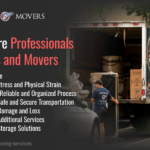NYC and Los Angeles are the two largest cities in the nation, but with a population of only four million people, Los Angeles is half the size of its East Coast counterpart. Alluring to many, the West Coast offers warmer weather, wide open spaces, and the most beautiful sunsets in the world. Are you planning a move from New York to L.A.? Read our guide to start your relocation on the right foot!
What to Know Before Moving to Los Angeles
Here’s what you need to know before trading your Big Apple life for a new start in the City of Angels.
The Weather
Southern California enjoys a Mediterranean climate. The air is dry and hot most of the year with mild winters. Along the coast, the ocean breezes cool things down. Temperatures can peak over 100 degrees, but average summer temperatures hover around 85.
The rainy season usually lasts from February to April. In that time, Los Angeles typically receives a mere 12 to 15 inches of precipitation. Snow might fall once a decade but barely lasts more than a few hours. Lingering ice is rare.
The strong Santa Ana winds, also known as “the devil winds,” sweep across the Los Angeles basin when inland temperatures rise. In drier months this increases the risk of wildfires and spreads clouds of dust and smog.
Traffic and Driving
Los Angeles and New York compete for the honor of having the worst traffic in the country. The highway system of the West Coast is robust but overwhelmed by the number of drivers. Unlike on the East Coast, California has the space to build broad, multilane highways, and drivers fill those roads to the brim.
With a dominant car culture in Los Angeles, most insist on taking personal transportation. The LA Metro system provides public bus and commuter rail lines, but this resource is underdeveloped and underutilized.
To complicate matters, most highways do not impose tolls to discourage excess use. A few California freeways have optional toll fast lanes, carpool lanes, and ride sharing programs. If you are in a hurry, you can register to pay the daily express lane toll on Interstates 110 and 10.
Taxes
The tax situation in California is like that of NYC, but LA does not charge residents a separate income tax for living in the city. Instead, Los Angeles increases its tax revenues with a sales tax rate that’s higher than the rest of California. Here’s a break-down of the taxes you can expect to pay in L.A.:
- 5% sales tax in Los Angeles
- 16% average property tax for Los Angeles County
- A marginal state income tax rate as high as 13.3%
Income tax brackets in California begin at 1% and only those earning over one million dollars a year should have to worry about the highest tax bracket. If you have a middle-class income, expect to pay close to a 9.3% marginal rate.
California generates revenue for infrastructure through fuel taxes. Be prepared for the highest gasoline prices in the nation.
Real Estate
Home prices in Los Angeles are just as high as they are in New York City. The average home in this sunny city costs over $600,000. The real estate market is especially hard on first-time buyers with most lenders requiring six-figure incomes to qualify.
Los Angeles has a wider variety of property options than NYC. High rises apartments, townhomes, and luxury condos are popular, but you may also buy a single-family home on a private lot in a residential neighborhood.
Things to Do
The Los Angeles area has a bouquet of family-friendly theme parks for you to enjoy at your leisure. Disneyland, Universal Studios, Knotts Berry Farm, and Six Flags Magic Mountain are all close.
There are also eight major professional sports teams competing in the four most popular leagues. The convention center in Downtown LA hosts special events and concerts, and trendy clubs and nightlife hotspots frequently host celebrity visitors.
You can also explore Southern California’s natural beauty by visiting any of the beaches along the Santa Monica Bay or traveling through the San Gabriel Mountains. World class art museums like the Getty Center and the Museum of Contemporary Art put you in touch with human-made beauty.
Cost of Living
The cost of living is high in Los Angeles, and the median income is in the mid $50K range. In addition to the high taxes, the average apartment rents for over $2000. Don’t let this discourage you though. These average rates factor in the luxury apartments. Modest two-bedroom homes rent for $1700.
Also, consider budgeting for a vehicle. It’s more common to depend on your own transportation in California than it is on the East Coast.
Job Markets and Employment
Los Angeles is famous for the entertainment industry, and the creative economy still dominates. Many residents refer to themselves as freelancers or contractors working in local museums, theaters, fashion, and broadcasting.
As a major hub of commerce, the financial sector is also strong, and the center of the city employs professionals and service providers for the many insurance, banking, and investment businesses. Los Angeles also has a strong aerospace manufacturing and engineering economy. The Port of Los Angeles supports factories in the south and creates jobs in transportation, warehousing, and logistics.
Best Neighborhoods in Los Angeles, CA
To the casual observer, Los Angeles County looks likes one giant urban sprawl, but each community has its quirks. Here are some of the top places to consider living:
Downtown LA
Office skyscrapers crowd the center of town, but you can find luxury apartments in many of the high-rises with monthly rental rates starting just above $2000. These residences are attractive to working professionals who don’t wish to waste hours commuting.
While the city’s reputation hasn’t always been the brightest, the downtown area underwent an urban renewal at the beginning of the new millennium. Now fashionable, you’ll find swanky nightclubs and fine dining, and your right next to the city’s impressive arts district.
Something to Try: Watch the NBA Lakers play at the Staples Center.
Hollywood
Hollywood became famous as the film business developed around it. Today, it is still the most influential spot in the nation’s entertainment industry. If you are talented and hardworking, you could find employment in movies, television shows, and advertising.
West Hollywood has residential communities intermingled with trendy nightclubs, bars, comedy venues, dining, and shopping. Head north through the Hollywood Hills to visit Griffith Park to enjoy the natural environment or check out the view of the entire city from Griffith Observatory next to the Hollywood sign.
Something to Try: Enjoy a live performance at the Hollywood Bowl.
Beverly Hills
Though this neighborhood is affluent and expensive, residents here are still friendly. The average home price is over three million dollars, and the area remains free from most of the usual traffic issues plaguing the rest of Los Angeles. Six-figure incomes are typical for those employed in the entertainment business, but there are plenty of good jobs in the services industry. More affordable housing options exist next door in Beverly Grove.
Upscale shopping along Rodeo Drive attracts patrons as well as tourists, and you will find art galleries and opulent architecture that visually communicates the area’s wealth.
Something to Try: Visit the Greystone Mansion, the site of many famous film scenes.
Silver Lake
This small community is just to the north of the central downtown district and gets its name from the reservoir located in its center. Green spaces and walking trails along the edge the lake give residents a break from the urban sprawl surrounding the rest of Los Angeles.
Silver Lake is less expensive than the rest of Los Angeles, and the progressively minded residents are tolerant of new ideas. Street art, vegan cafes, craft breweries, and unique coffee shops mingle throughout the neighborhood. Interstate 5 and Highway 101 pass close to the community facilitating an easy commute to major employers.
Something to Try: This is pet-friendly neighborhood – take your dog for a walk at the Silver Lake Dog Park.
The South Bay
This vast region sits along the southern shoreline of the Santa Monica Bay. It offers more affordable access to the coast than the pricier neighborhoods to the north like Malibu and Venice. Housing prices vary, and you’ll find traditional neighborhoods mixed with luxury condos and apartments.
Hawthorn and Torrance are inland. El Segundo, Manhattan Beach, and Redondo Beach sit on the edge of the Pacific Ocean. The region continues south through the Palos Verdes Peninsula and ends near Long Beach.
Blue collar workers find employment in the manufacturing, transportation and energy industries. Aerospace companies like Northrop Grumman and Boeing have facilities close. Warehouses along the Port of Los Angeles keep material handlers, truck drivers, and supply chain professionals busy.
Something to try: Ride your bike on the paved Marvin Braude Bike Trail commonly referred to as “The Strand.”
Echo Park
This small community is right next door to the downtown area, and it features some of the most accessible green spaces within the city. Echo Park gets its name from a small lake surrounded by a public park. Dodger Stadium is on the east side of the community just south of Elysian Park.
Echo Park has a lively nightlife and plenty of dining options. Young working professionals benefit from affordable housing options and the proximity to major employers.
Something to Try: Rent a paddle boat for an afternoon on the water of Echo Park Lake.
The Valley
The flat open San Fernando Valley stretches north past the Hollywood Hills. Land developers turned this featureless plain into a collection of suburbs where commuters find more spacious and affordable housing options.
Two significant interstates connect you with the rest of the city and facilitate your access to the rest of Los Angeles. The Valley also has more strip malls and outlet shopping centers.
Something to Try: Check out the NoHo Arts Center in North Hollywood.
Glendale
Glendale is north of Los Angeles along Interstate 5, and it is another alternative to paying the high cost of living downtown. Historically, immigrants have favored this community. More recently, renovation has transformed the area, though it is still one of the best places to find a variety of ethnic dining options.
The animation industry has its roots in Glendale. Disney and DreamWorks Animation both operate studios in town and employ artists, writers, and directors.
Something to Try: Hike the Beaudry Loop Trail and take in the views of the Los Angeles skyline.
Culver City
Culver City is not technically part of the City of Los Angeles. Strangely, the Los Angeles city limits envelop this pocket community, but Culver City remains autonomous from the metropolis.
Culver City is known for historical contributions to film, aviation, and broadcasting. Though not as dominant as Hollywood, Culver City does have a robust studio and film industry with Sony and Columbia Pictures operating here.
Something to Try: Take the Sony Pictures Studio Tour to see the famous film and television sets.
Pasadena
Once a stop on the old Santa Fe Railway, Pasadena grew into a self-sustaining city. Old Pasadena is known for its classic Victorian-era architecture and art deco styling. Unique shops and dining options draw in the tourists, and the pubs and bars provide plenty of evening entertainment.
Its economy is stable and diverse. If you don’t want to commute to Los Angeles, you may find work locally in aerospace manufacturing or the healthcare industry.
Something to Try: Attend the Rose Parade hosted by the City of Pasadena every year.
Tips for Moving Cross Country from NYC to Los Angeles
Los Angeles is a long way from NYC, so relocation mistakes are expensive to correct. Follow this short guide to help you plan and execute your move.
Phase One: Preparation
The first rule of moving is downsizing. This step is especially crucial for a long-distance move. Reduce the number of your belongings to lower your transportation and storage costs.
Start by taking an inventory of everything you own. Sell, donate, or throw away the things you don’t need or want anymore. Several weeks before you leave, place advertisements online or host a moving sale to liquidate as many items as possible.
You also need to notify everyone important in your life that you are heading West. Aside from your family and friends, you must provide formal notices to your business and professional contacts:
- Notify your current landlord at least 30 days before you depart.
- Provide at least a two-week notice to your employer.
- Let your creditors and bank know you are moving within 30 days of the event.
- Transfer medical files and prescriptions to your new location two weeks before you move.
- Collect school records and course transfer information before the move.
- Update your contact information with all subscription and service providers.
- File a mail forwarding address the post office the week you leave New York.
If you don’t already have an address in California, consider establishing a post office box. Also, arrange for temporary storage in New York or Los Angeles to hold your things while apartment shopping.
Phase Two: Packing
Consider hiring a professional moving service, like Imperial Movers, to do the hard work of hauling your possessions across the country. Our team of movers will arrive at your home on the scheduled day to help you pack up and go.
Depending on your needs, there are several levels of service available:
- Basic Transportation – The movers load up a truck and haul your heavy items for you.
- Partial Pack and Haul – Movers help you package up certain belongings or areas of your house.
- The Full-Service Move – Experts completely pack and relocate your belongings for you.
Always purchase the additional protection for your move, and only work with a licensed and insured company. Imperial Moving & Storage is licensed through the Federal Motor Carrier Safety Administration (FMCSA), so we have the credentials to help you move to Los Angeles or anywhere else in the country. Most movers offer insurance options like full value and released value protection to help offset your losses if there is an incident.
If you do insist on performing the move yourself, give yourself several months to pack and plan your route. Research truck rental options and reserve equipment as soon as possible.
Phase Three: Travel
The most obvious way to transport a personal vehicle across the country is to drive it yourself. A road trip can take several days, and costs quickly rack up as you pay for meals and accommodations along the way. It might be cheaper and easier to ship your car and take a flight to Los Angeles.
If you do decide to make the drive yourself, you have several options. The fastest route is 2800 miles and cuts across the Midwest. You could also drive all the way south to Florida and take Interstate 10 directly to Los Angeles.
Get your vehicle inspected before you attempt the journey to avoid any complications due to mechanical problems. If you are traveling in winter, be prepared to face snow and ice through the mountainous regions.
Phase Four: Settling In
Once you arrive, you have ten days get your California driver’s license from the time you establish your residency. You have 20 days to register your vehicles.
For your driver’s license, expect to take the written test and pay a fee. Study the California driver’s handbook ahead of time. To register your vehicle, you must show physical proof of the state minimum insurance requirements, and your car must pass a comprehensive emission and safety check. California DMV collects some of the highest registration fees for vehicles in the nation, and costs depend on the vehicle’s value. Check the California DMV online fee calculator to estimate your expenses.
You can also register to vote at this time and start participating in elections. You may attend local colleges right away, but you will not qualify for in-state tuition rates until you’ve been a resident for a year.
And Finally
Take a drive around Los Angeles and get familiar with the streets and locations. Make sure you know your route for getting to work. While you’re at it, keep an eye out for fun new things you might like to try.
For help planning your move from NYC to LA, call Imperial Moving and Storage. As one of NYC’s best interstate moving companies, we can make your cross-country relocation a snap. Call now to request a free moving quote!












